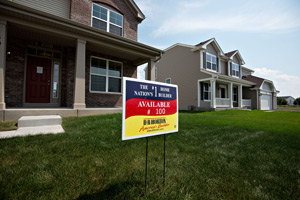Sales of New Homes Declined More Than Forecast in January

Purchases of new homes dropped more than forecast in January as contract signings slumped in the western United States by the most since May 2010.
Sales declined 9.2% to a 494,000 annualized pace after a 544,000 rate in December that was the strongest in 10 months, Commerce Department data showed Feb. 24. The median forecast of economists surveyed by Bloomberg News called for 520,000. Sales in the West fell 32.1%.
The drop in January brings new-home purchases more in line with the steady pace of progress since the end of the recession. Persistent job creation, signs of bigger wage growth and cheap borrowing costs are buoying sales and helping alleviate the weakness in factory output tied to sluggish global demand.
“At the end of the day, if the labor market is still improving, household spending in general probably is going to be doing fine,” Jim O’Sullivan, chief U.S. economist at High Frequency Economics in Valhalla, New York, said before the report. “Assuming the economy keeps chugging along here, I would assume that housing will do more than its share.”
January sales were the weakest in three months. Estimates of 75 economists in the Bloomberg survey ranged from 500,000 to 552,000. While the December sales data were unrevised, the Commerce Department revised up November figures.
The January data should be considered as preliminary. The report said there was 90% confidence the change in sales last month ranged from a 22.7% drop to a 4.3% increase.
In addition to the decline in the West, where the 110,000 annualized sales pace was the weakest since July 2014, purchases dropped 5.9% in the Midwest. Sales advanced 3.4% in the Northeast and 1.8% in the South.
The supply of homes increased to 5.8 months from 5.1 months in December. There were 238,000 new houses on the market at the end of January, the most since October 2009.
The median sales price of a new house decline 4.5% from January 2015 to $278,800.
New-home sales, which account for about 10% of the residential market, are tabulated when contracts are signed. That makes them a timelier barometer than transactions on existing homes.
Previously owned home purchases unexpectedly rose in January to the second-fastest pace since February 2007, National Association of Realtors data showed this week. Closings advanced 0.4% to a 5.47 million annual rate. Prices climbed from January 2015 as the number of dwellings on the market dwindled.
The residential real estate market continues to benefit from healthy gains in employment, budding wage growth and cheap borrowing costs.
The jobless rate reached an eight-year low of 4.9% in January, while hourly earnings rose more than estimated after climbing in the year to December by the most since July 2009.
The average rate on a 30-year, fixed mortgage held at 3.65% in the week ended Feb. 18, the cheapest since April and close to the record-low 3.31% reached in 2012, according to Freddie Mac figures dating to 1971.


